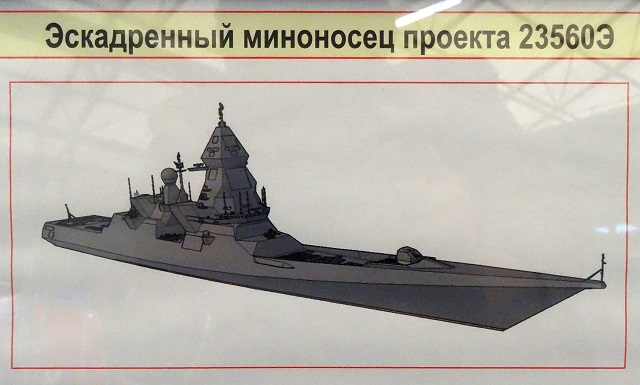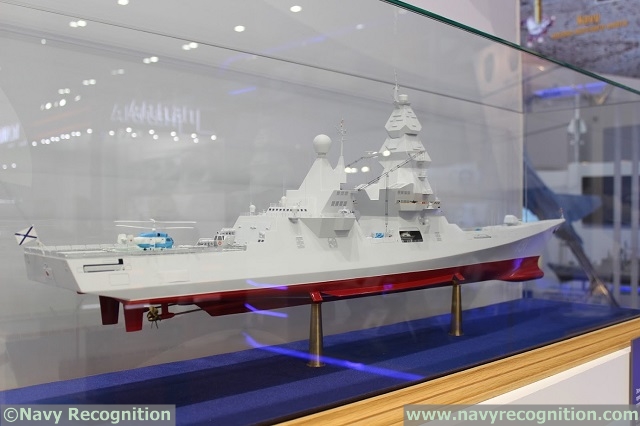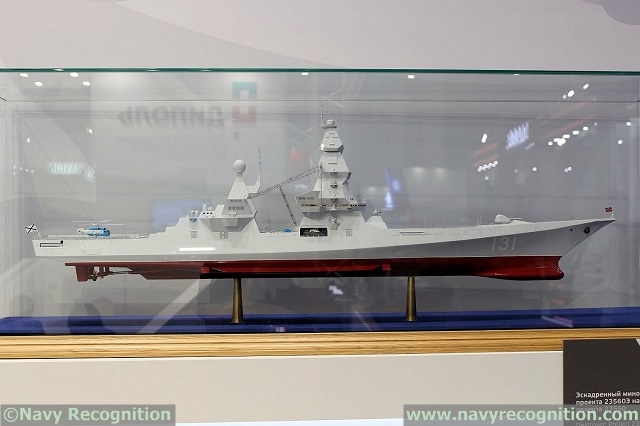|
|
|||
 Project 23560 Leader-class destroyers are expected to replace Project 956 (Sovremennyy-class) destroyers due for decommissioning in five to 10 years and some of the Project 1155 (Udaloy-class) antisubmarine warfare destroyers (pictured here). Project 23560 Leader-class destroyers are expected to replace Project 956 (Sovremennyy-class) destroyers due for decommissioning in five to 10 years and some of the Project 1155 (Udaloy-class) antisubmarine warfare destroyers (pictured here). |
|||
|
|
|||
|
In Ilya Kramnik’s opinion, the advanced Leaders will replace the Project 956 (Sovremennyy-class) destroyers due for decommissioning in five to 10 years and some of the Project 1155 (Udaloy-class) antisubmarine warfare destroyers.
"The mainstay of our blue-water navy is to be eight Leaders and upgraded Soviet-built ships. The first of the latter will be the Admiral Nakhimov (Kirov-class) that is being repaired by Sevmash, as is known," Kramnik said. Prokhor Tebin, too, assessed the feasibility of Russia’s gaining a full-fledged blue-water navy in case the Leader program is carried out. In Tebin’s opinion, Russia will only lack an advanced aircraft carrier and a versatile amphibious assault ship: "Overall, even lacking the carrier and LHD and considering the nuclear submarine fleet, future destroyers and ships in other classes, it will be a rather balanced oceangoing navy able to accomplish a lot of missions." |
|||
|
|
|||
 Image showing the notional design of Project 23560E "Shkval-class" Destroyer (export variant of Leader-class) as of mid-2015. Image: forums.airbase.ru Image showing the notional design of Project 23560E "Shkval-class" Destroyer (export variant of Leader-class) as of mid-2015. Image: forums.airbase.ru |
|||
|
|
|||
|
Judging by recent media reports, eight Project 23560 ships are slated to be built. From Tebin’s point of view, the number of destroyers is the minimally acceptable one: "By rule of thumb, we need a ship on a long-range cruise, at least one for operating near the home shore, one for training and one for repair. As for two ocean-going fleets, the total number of the ships is eight. Thus, this is the minimal number allowing effective operations. Whether they will be built is quite another kettle of fish. Let’s hope for the best."
"There should not be a problem with the engine for the advanced ships," Ilya Kramnik maintains, "because the Leader is being designed as nuclear-powered cruiser, and we already have a nuclear propulsion plant developed to equip RITM-200 icebreakers. It was developed as a versatile one from the outset. Hence, a power plant for warships can be derived from it. In theory, the Navy may order the development of a nuclear propulsion plant for an aircraft carrier, if it decides so. In other words, Russia is in a better position in terms of nuclear power plants than gas-turbine ones, because all relevant designers and manufacturers are here. Gas turbines pose a bigger problem for obvious reasons, but hopefully our engineers will manage to develop gas-turbine propulsion plants to equip frigates." The expert also noted that there should be no problem with the weapons suite of the advanced surface combatant, because "it has been developed and proved itself." The air defense system is being tested on the new-generation Admiral Gorshkov (Gorshkov-class) frigate and other ships of the class. Let’s hope that there will have been the complete standardized weapons suite to fit out the Leader by the time her keel is laid, which, I guess, will take place in 2018 at the earliest." |
|||
|
|
|||
 Scale model showing the Project 23560E "Shkval-class" Destroyer (export variant of Leader-class) at Army 2016 exhibition. Twelve ships of the 10,000t "Leader class" are planned to enter service from 2023-25, split between the Northern and Pacific Fleets. They will all be nuclear powered. They will be fitted with the ABM-capable S-500 SAM and Kalibr (SS-N-27) cruise missile. Scale model showing the Project 23560E "Shkval-class" Destroyer (export variant of Leader-class) at Army 2016 exhibition. Twelve ships of the 10,000t "Leader class" are planned to enter service from 2023-25, split between the Northern and Pacific Fleets. They will all be nuclear powered. They will be fitted with the ABM-capable S-500 SAM and Kalibr (SS-N-27) cruise missile. |
|||
|
|
|||
|
The experts’ opinions differed on the recently reported deadlines for the Leader’s development and construction. As is known, the first Leader is slated for laying-down as soon as 2018.
"As for a ship as big and complex as a destroyer - essentially, a new-generation cruiser in terms of technology and dimensions, the deadline usually slips behind schedule," Prokhor Tebin remarked. "This is true for everybody, be it Russia or the United States. The latest US aircraft carrier, which keeps on slipping, is a good case in point. I would not say that it is no drama at all, but this is life. I do not think the program will be delayed much, but if it is, the less, the better." Asked about the construction timeframe, Ilya Kramnik noted the problems facing industry as a whole: "Unfortunately, our shipbuilding is not in good shape. Everything will depend on what shipyard lands the order and how the latter will be financed. I hope that if they start carrying out the order at all, they will have been able to assess risks realistically by the time the lead ship is laid down, so that we avoid a 10-11-year-long delivery delay. If industry will have been squared away by the time, building a ship will take seven to eight years from cutting metal to delivering her to the Navy. I mean the lead ship. The construction of production-standard ones will take four to five years." Lenta.ru’s military columnist stressed that the matter of financing consists in not only the funds set aside for the ships per se, but the money for shipbuilding modernization as well. Both experts were cagey about the financing of the program. "It depends on various considerations, e.g. whether there will be money allocated for research and operation or not, so on, so forth," Prokhor Tebin said. "The program is absolutely feasible in engineering, technical and economic terms. However, Russia’s peculiarities should be taken in account too: we need the Navy, on the one hand, but it has been sidelined repeatedly," Ilya Kramnik summed up in his interview with the Defence.ru network news agency. © Copyright 2016 TASS. All rights reserved. This material may not be published, broadcast, rewritten or redistributed. |
|||
Expert Opinion on Future Russian Navy Project 23560 Leader-class Nuclear-Powered Destroyers
- Posted On











